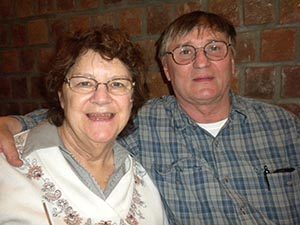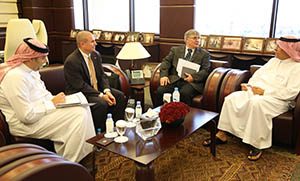
The council has benefited from Chicago-born Tom Kuckertz’ broad experience in engineering for 16 years and counting. After his retirement from the council in 2014, Kuckertz continued on as a volunteer for the committee he worked with most closely, the Terminal Operations and Environmental Monitoring Committee.
A young Kuckertz earned degrees in electrical engineering at the University of Illinois and the University of Idaho, followed by two years in the U.S. Army as a Signal Corps officer, where he was involved in the design and implementation of large communications systems.
“Basically, it involved how to move information from one place to another, and in most cases, deny access to adversaries,” explained Kuckertz.
Following the Army, Kuckertz earned a PhD in electrical engineering at the University of Idaho and went to work for the Los Alamos National Laboratory, in New Mexico. The Los Alamos lab, at the time run by the University of California, is a science lab that focuses on nuclear weapons and other national security challenges.
At the Los Alamos lab, Kuckertz developed “computer-controlled data acquisition systems.” A data acquisition system measures a real world phenomenon, then converts the data from the measurements into a form that can be analyzed by a computer. It’s how computers control machines.
“For example, you have embedded control systems in your cars these days. One of my specialties was embedded control systems for acquiring nuclear physics data.”
Kuckertz and several fellow engineers started a company called Pajarito Scientific Corporation, named after the plateau where the laboratory was located. The new company’s systems specialized in instruments to measure the nuclear waste in containers, typically 55 gallon drums or larger boxes.
The systems that Kuckertz created could “assay,” or very accurately measure, small quantities of nuclear waste without opening the drums, important to keep the nuclear waste contained.
“We could tell you how much material was in there, down to sub-milligram quantities. The measurements were expensive, but very precise, very accurate.”
“I developed the mathematics for doing that kind of stuff,” he said. “They were things that people said you couldn’t do.”
The company was eventually sold to British Nuclear Fuels Ltd, although Kuckertz stayed on as an employee for a few years. Sadly, just as his employment contract came to an end in the spring of 2000, Kuckertz and his wife Sue lost their home to the massive Cerro Grande forest fire.
The Kuckertz’ two kids, Patrick and Carolyn, were living in Alaska, so he looked here for work, and was hired at the council where he managed projects for the next 14 years.
“I got crosswise with a few people now and then, but it was all over technical issues and what was appropriate.”
As a committee volunteer
One of the recent issues the council has been concerned about is the liners of the secondary containment system around the crude oil storage tanks at the Valdez terminal. The secondary containment systems surround all the tanks to catch oil and prevent spills from contaminating the environment.
The condition of the liners is important because Alyeska receives a “prevention credit” based on the overall integrity or condition of secondary containment systems. This credit allows Alyeska to plan for a smaller spill volume and therefore have less response equipment and personnel available locally.
“The secondary containment cells have a liner that was sprayed on using catalytically blown asphalt, that’s sort of like spraying tar. It forms a liner that is subject to ultraviolet degradation, so you can’t just leave it out in the sun. So it’s covered with an ‘overburden’ which is gravel and dirt.”
The overburden protects the liner from ultraviolet and mechanical damage such as driving vehicles on top of it. The liner is also susceptible to damage through prolonged contact with hydrocarbons like crude oil. Over the years, excavation for activities such as servicing manholes required digging into the overburden, which sometimes damages the liner, necessitating repairs. The committee would like to be able to recommend a method of inspecting the liner without further damaging it.
“Once you dig, you raise the risk very substantially of damaging it, just by inspecting it,” Kuckertz says. “In addition to the fact that digging up the overburden is very costly.”
Kuckertz thinks some of the methods he used in his work in New Mexico could have some potential answers.
“Much like we did with the nuclear waste, some type of penetrating radiation, typically, such as electromagnetic ground penetrating radar, if it will penetrate far enough, or perhaps you can use acoustic interrogation, which means that instead of electromagnetic waves you use sound waves.”
Kuckertz says the idea of using waves to “see” could be described much like radar is used to track airplanes.
“The waves encounter a discontinuity in the transmission medium, namely the liner. In the case of radar, it encounters an airplane, that’s a discontinuity, so you get a reflection in the waves. It’s a basic physics principle. You can measure that reflection and see what it looks like.”
Kuckertz says that the measurements coming from the reflection will be different depending on the characteristics, such as a crack, of the liner.

“A smooth surface would have one kind of reflection. Cracks and other imperfections would have another kind of reflection,” Kuckertz says. “That’s called the ‘signature’ of whatever you are looking for. In the case of the airplane, you know what the particular signature of an airplane looks like, and that signature varies based on whether it’s moving or not. It tells you where it is.”
In the case of the secondary containment, Kuckertz says the key would be determining the right type of waves, whether electromagnetic, acoustic, or another type.
“That’s been a hard sell,” says Kuckertz. “The biggest problem is not knowing what the signatures of the cracks and imperfections look like as opposed to imperfections in the crack and inhomogeneity in the overburden.”
Kuckertz says that no matter the final method, it’s important to find something that works.
“If it’s going to be really expensive to remove the overburden once a year to look for cracks, no one is going to do that. But if you can use some type of instrument, and roll it around on the ground, that’s a lot less burdensome.”
Science saves lives
Kuckertz described a use of sound waves that his team helped develop while he was at the Los Alamos Laboratory that probably saved lives.
“In the first Iraq war, we had all these artillery shells that were captured. Some of the shells were filled with liquid biological nerve agent, and some were filled with explosives.”
The shells looked alike, and the Army had trouble telling them apart, which created a dangerous situation.
“The method of destroying these shells was different. The liquid needed to be burned in a furnace, but you would blow your furnace up if you put the high explosive shells in there.”
They developed an instrument that analyzed the frequencies of sound wave reflections to help separate the nerve agent shells from the explosive shells.
“That was basic physics,” said Kuckertz.
Please note: There have been several corrections to this story from the version that was in the print edition of the January 2017 Observer.